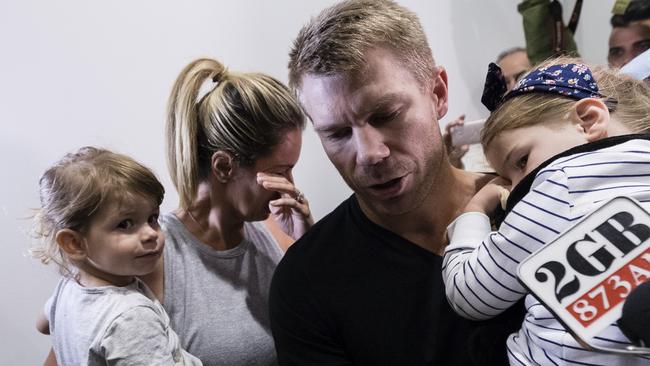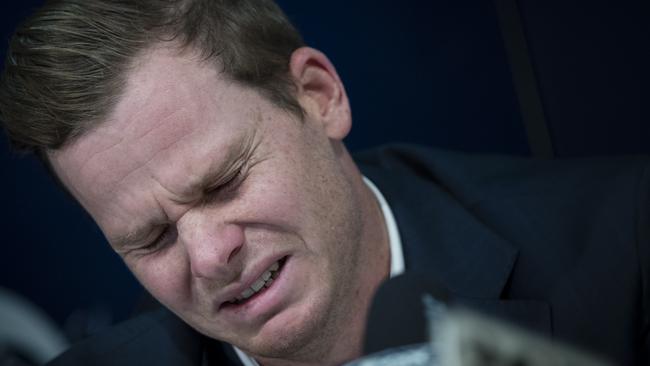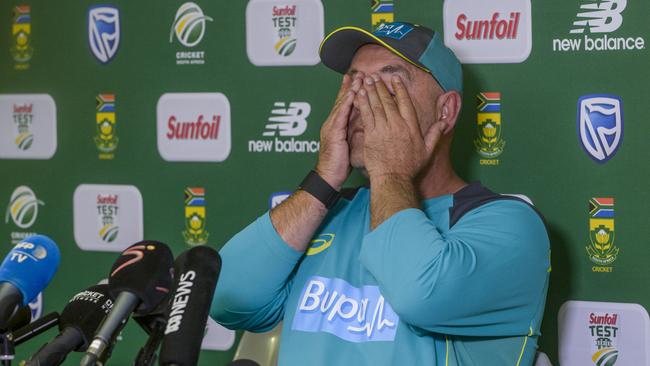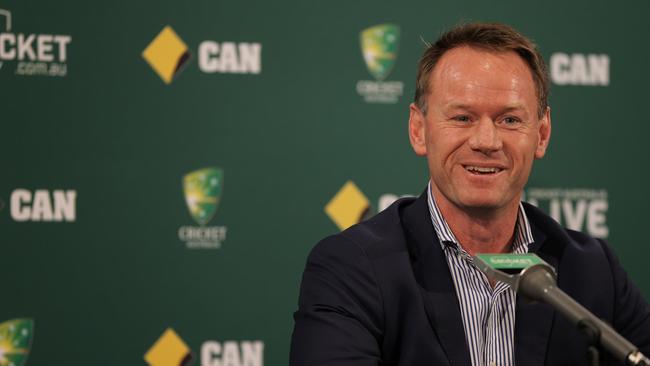Cricket’s darkest day: One year on from sandpapergate where are the main protagonists of the scandal?
Hard to forget where you were when news of the ball tampering scandal broke in 2018. Twelve months on from one of Australian cricket’s darkest days, we take a look at where the main characters of the scandal are now.

Cricket
Don't miss out on the headlines from Cricket. Followed categories will be added to My News.
David Warner hardly said a word before his real return to cricket in the Indian Premier League.
He used to captain the Sunrisers Hyderabad. He captained them to an IPL title.
But in the wake of the ball-tampering scandal, that infamous incident to which he will be forever linked, and one for which he will seemingly be forever blamed, he was sacked from the team entirely.
Warner also had his $2.4 million contract torn up, and was told, by Cricket Australia, he would never be a national leader again.
Sunday didn’t mark his first game since the ban, both Warner and Smith haven’t not playing any cricket.
David Warner rang his teammates to ask for forgiveness for his role in ball-tampering scandal

After spending some time, immediately after being handed the biggest penalties in Australian cricket, after crying as they tried to explain themselves, after avoiding the spotlight, they bobbed up in, of all places, Canada.
Then they played club cricket, then in Bangladesh.
But now, with their international bans about to expire, they have re-entered the fray more significantly.
Not only are they playing in the biggest T20 league in the world, mixing with the world’s best players, but they are being scrutinized again.
Less for what they are saying, because, really, they are yet to be fully put under the glare of hard questioning, but more for what they are doing.
Twelve months in the wilderness, and a couple of elbow injuries, has seemingly done nothing to diminish their ability with the bat.
Warner made 85 in that innings for Sunrisers, Smith just 20 in his only innings so for the Royal Challengers.
But Warner’s pre-match nerves, from a player nicknamed “Bull” because of his preparedness for any fight, on field or off, spoke volumes.

“(Normally) I am pretty chirpy in the change room (before a game). I didn’t really say much. I was that nervous, I went to the toilet a couple of times,” Warner said.
Warner nervous ? What a different cricket world we live in now, 12 months after one of the darkest days in Australian sport.
“It’s a totally different set-up to when they left it,” Australian one-day captain Aaron Finch said after meeting with Smith and Warner in Dubai nearly two weeks ago.
Finch, maybe more than any player, has benefitted from their bans. Not only is he ODI and T20 captain, roles Smith and Warner had both filled, he also got to play Test cricket.
“It is a different time and they have been out for quite a while.”
So much has changed.
THE BANNED BOYS
NOW bearded and, you would hope, chastened by the experience, David Warner seems on the surface to have embraced his time in the wilderness on a different level to Smith and the third member of the Cape Town trio, Cameron Bancroft.
For one thing, he has children, and ploughed in to “just being a dad”. Out of the “gilded bubble” which moulded a player, and a man, who polarized Australian cricket fans, he stayed silent too.
Warner did most of his talking at his club, Randwick, a place where he felt wanted, and needed, as former Test fast bowler Mike Whitney could attest to.
“As the president of Randwick Petersham Cricket Club, and I have been at that club for 44 years now … I couldn’t have asked him to do any more,” he said.
He trained, took training, even when he wasn’t required. There’s a story of him seeing young girls training, and just helping out, because he could.

Smith too, for his club Sutherland, was on hand to drag covers on and off suburban wickets on rainy days, had sandwiches in club rooms before walking through white picket fences to bat.
The former Australian Test captain, for whom 12 months on the sidelines and another year to be spent out of any leadership roles, arguably had the largest fall from grace.
But, apart from what some deemed an ill-timed and mis-guided Boxing Day interview in which he threw his old mate Warner “under the bus”, has swallowed his pride and got back to the precipice of his international return with a growing sense of national expectation.
He didn’t enjoy playing for Sutherland at all, and stewed that he should have at least been allowed to play for NSW.
But he excelled where he was and even helped take Sutherland to the national T20 finals.
He coulnd’t play, because of that elbow injury suffered in Bangladesh, so he coached, travelling with Sutherland to Adelaide, where they fell at the final hurdle.

He was a regular presence at NSW training too, embraced by his teammates, and not the pariah some would think a man dubbed a “cheat” and a “national disgrace” to be.
Bancroft too has climbed his way back in the game with little or no discernable hangover.
When he returned from his nine month ban in the Big Bash, there was next to no fanfare.
He plied his trade for the Perth Scorchers, then moved his way in to the Sheffield Shield, banged out a century first up, and now it’s like he never left.
Bancroft, new and improved after spending his suspension doing a lot of yoga, has even been, staggeringly, elevated to the captaincy of English county side Durham, although not with everyone’s approval.
Former English fast bowler Darren Gough called it a “disgraceful decision”.
“You only have to look at some of his interviews and how he talked about that (ball- tampering) situation. That doesn’t show great leadership,” Gough said.
“Just putting some sandpaper in your pocket and trying to scratch the ball. That’s not leadership skills.”
Warner and Smith will be part of Australia’s World Cup campaign after their IPL stint, they’ll play in the Ashes in August too. Bancroft will likely have his county stint interrupted by Australia A duties too, and could even make a Test return after showing good early signs.
Where are they now ? Back to where they were before.

THE BOSS MAN
AS Cricket Australia chief executive, James Sutherland was the man who decided on, got board approval for, then handed down the bans for the Cape Town trio.
He was woken at 3am on a Sunday morning last March by a CA staffer who told him what had happened in South Africa.
A few hours later he confronted a wild media pack outside the MCG, and struggled to explain what had happened, or what he would, or could, do.
Four days later he was in Johannesburg, telling another wile media pack that the Australian captain and vice-captain, and the Test team’s opening batsmen, were being sent home in disgrace.
Sutherland was front and centre for over a week, explaining the CA position and making sure it was the players who were held accountable.
It was his working mantra.
Smith, in his Boxing Day interview, didn’t miss Sutherland. He re-called the story of the CEO, staring down the players in the Hobart change rooms after a horrid loss to South Africa in 2016, telling them they “were paid to win”.

When Sutherland left his post last October, succeeded by the man in the office next door, Kevin Roberts, he left the ball-tampering fiasco, the scathing Longstaff review and the ugly pay dispute, all events of the past two years, in his wake.
The CA coffers are full, courtesy of a $1.18 billion TV deal, and the team environment was changing for the better. Some would judge that as a job well done.
On Friday, when the bans expire, Sutherland won’t be fronting any TV cameras. He could be at Royal Melbourne, playing golf. He’s yet to pursue gainful employment, instead enjoying his time away from the ‘issues rich” environment he existed in for 17 years as CA boss.
He’s on the board of the T20 World Cup, being played in Melbourne next year, and that could be the nest time the public sees him.
THE BOARD CHIEF
David Peever, in a nationally televised interview on the ABC, labelled the events in South Africa a “hiccup”.
It proved a telling blow, coming not amid the maelstrom when the scandal was unfolding, or even after the bans were handed down.
The CA chairman made the comments after the Longstaff review, and all its contents, so scathing of the culture which existed in cricket’s administration, a culture created under his watch, was revealed.
Peever didn’t actually make a single public comment about the scandal in South Africa until two weeks after the event.
He’d signed off on the bans, sacked an Australian Test captain, but didn’t take questions on them.
He’s not taking questions about them this week either.
Peever, who lives in Queensland, maintains a strong business presence. He’s still chairman of Brisbane Airport Corp and on several boards. He’s also a member of the Foreign Investment Review Board.
But there’s no cricket presence.

THE “WIN AT ALL COSTS” MAN
HIGH performance boss Pat Howard was one of the other dominoes to fall not immediately in the wake of the scandal, but when the culture which produced it was revealed.
Plenty of CA insiders say Howard was actually very good at his job, and a massive asset to the sport.
But others would say he helped created the “gilded bubble” and the “sense of entitlement” which clouded Smith, Warner and Bancroft from seeing just how bad what they did was.
Howard exited his role more than six months before his contract was to expire, courtesy of an elbow in the ribs from the new executive at CA, those ushering in change.
The qualified pharmacist has re-treated in to the relative safety of running the swag of chemists he owns, and overseeing his vast property portfolio.
It’s unlikely cricket will ever see him again.

